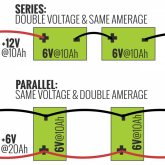Weldingunltd
New Member
- Joined
- Feb 9, 2021
- Messages
- 1
We have 8 100 watt solar panels mount on top of our travel trailer. We have an e-pever mppt solar controller and a Victron BMV 712, and 2 Battleborn 100 ah batteries ( we just upgraded to these from 4 100ah lead acid). We installed 8 panels with the expectation of being able to take in between 400 - 800 watts. We have never seen above 400 watts, and we usually only see around 150 watts on a sunny day, and much lower on slightly cloudy days. We are currently wired in parallel, but we have previously tried wiring in series. Neither offered the results we expected.




